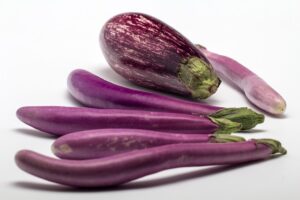Elevate your garden by growing eggplants! From sowing seeds to savoring the harvest, discover top tips for a bountiful yield. Happy gardening! 🍆✨

Introduction
Eggplants, known for their glossy, deep purple skin and creamy interior, are a staple in cuisines around the world. Not only are they a delight to cook and eat, but they also offer a rewarding experience for home gardeners. If you’re looking to enrich your farming endeavors with an abundant plant that’s not just ornamental but also adds a healthful punch to your meals, look no further than the humble eggplant.
In this comprehensive guide, we’ll take you through the entire eggplant growing process. We’ll cover everything from selecting the right variety for your climate and space to the final, sumptuous harvest. By the end, you’ll be equipped with the essential knowledge to nurture robust eggplants that you can proudly serve at your table.
Part 1: Choosing the Right Eggplant Varieties
The key to a successful eggplant harvest lies in the variety you choose. Factors to consider include the climate in your region, the space you have available, and your personal flavor preferences. Eggplants come in a range of shapes, sizes, and colors, and selecting a variety that suits your needs is crucial.
Before planting your eggplants, research the vast array of varieties available. From the classic deep purple ‘Black Beauty’ to slender ‘Japanese Long’, selecting the right type can greatly influence your gardening success and culinary adventures. Consider your climate and how you plan to use them in your cooking.
Climate Considerations
Eggplants thrive in warm weather and need a fairly long growing season. Varieties like ‘Black Beauty’ and ‘Rosa Bianca’ are well-known for their ability to grow in various climates, making them a good starting point for many gardeners. However, for those with shorter seasons, ‘Early Midnight’ is a quick-maturing option that can be cultivated in cooler regions.
Space and Needs
Some eggplant varieties are more compact and suited for container gardening. ‘Ichiban’ and ‘Patio Baby’ are examples of smaller cultivars that still produce excellent fruit. If you have ample garden space, consider larger varieties like ‘Oval Long Purple’ or ‘Italian Pink Bicolor’ for a bountiful harvest.
Eggplants thrive in warmth and direct sunlight, needing at least 6-8 hours of sun daily. Space your plants 18-24 inches apart in nutrient-rich soil, ensuring they have room to grow and flourish. A well-positioned eggplant can produce a bountiful harvest.
Personal Tastes
With varieties that range from mild and creamy to slightly bitter and savory, there’s an eggplant taste that’s just right for you. If you’re passionate about heirloom vegetables, ‘Diamond’ or ‘Listada de Gandia’ could be a great choice.
Part 2: Preparing the Soil and Planting
Eggplants, as with many vegetables, prefer well-drained, fertile soil. Start by testing the pH level of your soil. The ideal pH for eggplant is around 6.0 to 6.8. If your soil is too acidic, consider adding lime to raise the pH.
Soil Composition
Work in plenty of organic matter like compost before planting to ensure your eggplants get the nutrients they need. Your soil should also have good aeration, and if it’s too compacted, add some sand or perlite to loosen it up.
Depth and Spacing
Eggplants need space to grow. Plant them in rows with about 24 to 30 inches between plants. If you’re planting in containers, choose a pot that’s at least 10-12 inches in diameter to give the roots room to spread.
Time to Plant
Timing is everything. Eggplants should be planted in the garden after the last chance of frost has passed and the soil temperature has reached about 70°F (21°C). This typically happens in spring, but it’s essential to monitor local conditions for the best timing.
Part 3: Watering and Fertilizing
Consistent watering is important for eggplants, especially during the peak growing season. The soil should be kept evenly moist, but not waterlogged, to avoid root rot. A drip irrigation system or soaker hose can be an excellent water-saving method.
Fertilizer Regimen
Eggplants are heavy feeders, so they’ll appreciate regular fertilizing. Apply a balanced fertilizer at planting time and then side-dress your plants with organic compost every three to four weeks during the growing season.
Mulching for Moisture Retention
Mulch not only keeps the soil moist but also helps to control weeds. Organic mulches like straw or wood chips can also provide a slow release of nutrients as they break down.
Part 4: Protecting Your Eggplants
To ensure a healthy crop, you’ll need to keep an eye out for common pests and diseases that can affect eggplants.
Common Pests
Aphids, flea beetles, and spider mites are frequent visitors to eggplants. You can deter them with companion planting strategies or use insecticidal soaps if an infestation occurs, making sure to opt for organic and eco-friendly solutions.
Disease Prevention
Fungal diseases like verticillium wilt and potato blight can impact eggplants. To prevent these, practice crop rotation, keep the garden clean, and water at the base of the plant to avoid wetting the leaves excessively.
Part 5: Harvesting and Storing
It’s important to know when to harvest your eggplants. They should be firm and shiny with a deep color, typically when they’re about one-third to one-half their mature size.
Harvesting Etiquette
Use a sharp knife or pruning shears to cut the fruit from the plant, leaving some stem attached. This can help the fruit last longer once it’s picked.
Storing Your Bounty
Store your harvested eggplants in a cool, dry place or in the refrigerator. They’ll keep for a few days to a week, but it’s best to eat them as soon as possible for optimal flavor.
Conclusion
The satisfaction of growing your own food, like eggplants, is immeasurable. It not only yields fresh, delicious produce but also connects us to the natural cycle of the earth. By following the tips in this guide, you can enjoy a flourishing eggplant harvest that contributes to a sustainable and rewarding lifestyle.
